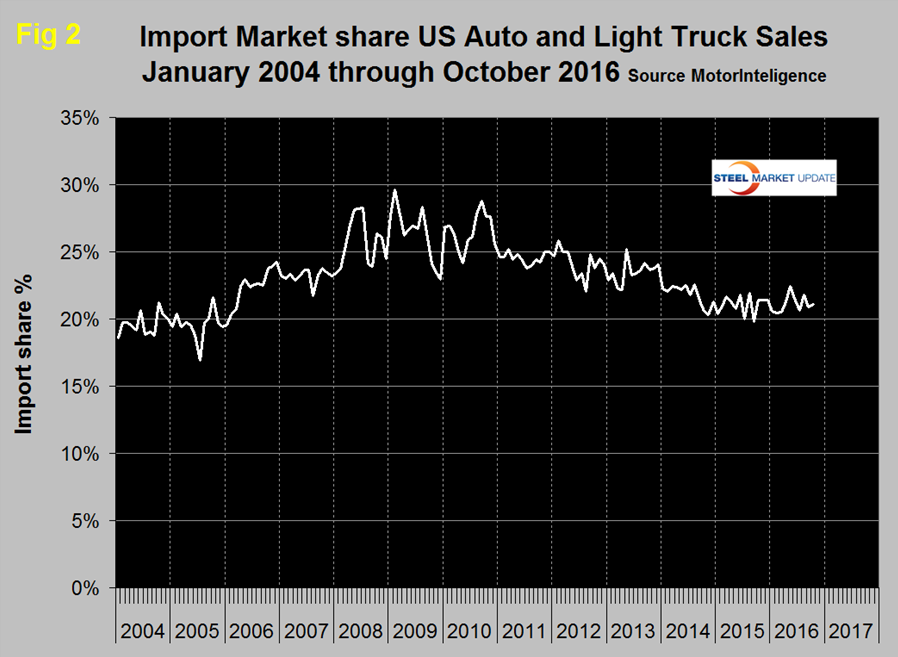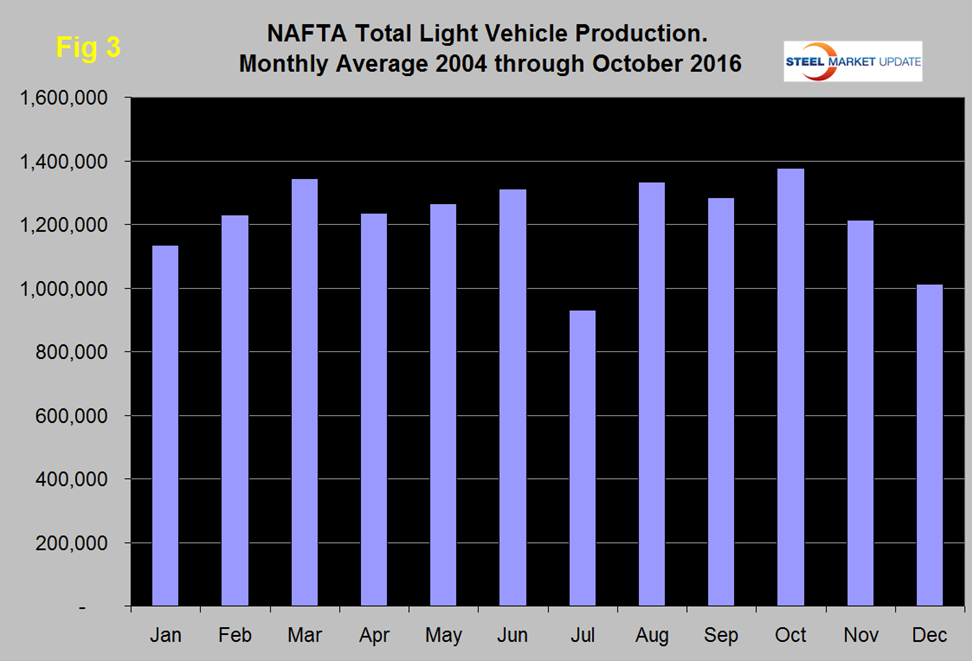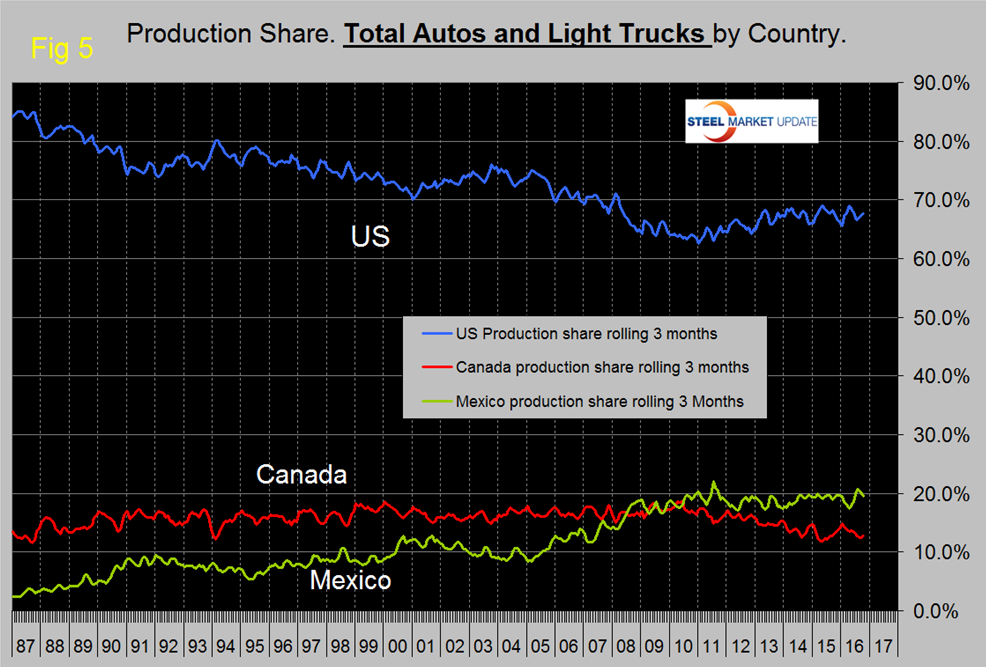Steel Markets

US Vehicle Sales and NAFTA Vehicle Production in October 2016
Written by Peter Wright
November 22, 2016
Vehicle sales rose to 18.0 million on a seasonally adjusted annual rate basis in October. This was the best result since November last year. Average monthly sales in the first ten months of 2016 have been 17.4 million units. A pace above the 17 million SAAR rate should continue through next year as the labor market tightens and incomes rise. However there is a cloud on the horizon. Vehicle sales may face financing headwinds for two reasons. First, the Federal Reserve is likely to enact a second rate hike next month. If this is the case, then rising rates will begin to chip away at the availability of low interest loans. Second, rising delinquencies could induce lenders to tighten lending standards. Delinquency and write-off rates have increased for recently originated auto loans.
Figure 1 shows auto and light truck sales through October.
Total sales in September were 17.7 million units. In October autos declined from 7.2 to 7.1 million and light trucks increased from 10.5 to 10.9 million. The mix in October was 39.4 to 60.6 percent which was the highest proportion of light trucks since our data begins in January 2005. Import market share in October was 21.1 percent which was exactly the same as the monthly average for the year (Figure 2).
According to Mexico’s National Automobile Association, sales in Mexico were 131,443 and exports were 235,612 units. US exports were 192,337 units. Reading between the lines of this data there must be a significant number of cars moving both ways across the border. We include this data here to illustrate how porous the Southern border is when it comes to finished autos and this also extends to sub-assemblies and parts.
Total light vehicle (LV) production in NAFTA in October was at an annual rate, of 18.994 million units, up from 18.393 million in September. In cases where seasonality is more than a weather effect we like to compare the monthly result with the monthly norm over a number of years. On average since 2004, October’s production has been 7.1 percent higher than September. This year production rose by 3.3 percent therefore was down slightly in the long term context (Figure 3).
We can expect November and December’s production to decline quite sharply. Reminder: production numbers are not seasonally adjusted, the sales data reported above are seasonally adjusted.
On a rolling 12 months basis y/y through October, LV production in NAFTA increased by 2.9 percent which was down from 3.0 percent in 12 months through September. There has been a very gradual slowdown in growth for the last three years as indicated by the brown bars in Figure 4, however production has been at an all-time high every month in 2016.
On a rolling 12 months basis y/y the US was up by 2.0 percent with positive momentum, Canada was up by 6.7 percent with negative momentum and Mexico was up by 1.5 percent with positive momentum (Table 1).
The four months July through October were the first months for Mexico to have positive momentum after fourteen straight months of slowdown. Canada experienced negative momentum in July through October following very strong momentum in the previous six months. On a rolling 3 months basis, Mexico has gained production share this year mainly at the expense of Canada (Figure 5).
In October on a rolling three month basis, the US production share of total light vehicles was 67.7 percent which was better than the average of 67.4 percent for the year. Canada’s was 12.8 percent which was less than the monthly average of 13.5 percent for the year. Mexico’s was 19.6 percent which was up from 19.1 percent for the first 10 months of the year. Production in Mexico in 2014 was 3.2 million units, in 2015 was 3.4 million units and through October annualized was 3.464 million units. The Mexican production target for 2020 in 5.0 million units according to Eduardo Solis, president of the Mexican Automotive Industry Association.
Figures 6, 7 and 8 show total LV production by country with y/y growth rates and on each the red line shows the change in production since Q2 2006.
Note the scales are the same to give true comparability and that Mexican growth has slowed significantly this year and, on a rolling 12 months basis, is the lowest in NAFTA. During the recession Mexico declined by less than the US and bounced back by more during the recovery. This caused Mexico’s production share to surge until Mid-2011 at the expense of the US.
Figure 9 shows the percentage of autos in the light vehicle production of each country.
The percentage of autos in the production mix of all three countries has been declining since 2012, driven by consumer buying preferences which in turn are heavily influenced by gas prices. The change in preference for light trucks tends to favor the US and Canada over Mexico because the mix of light vehicle production capacity is so different by country. The percentage of autos in the Mexican mix in the last three months was 56.7 percent but only 32.9 in the US and 34.1 percent in Canada. This means that Mexico has staked out a higher relative capacity in autos which will serve it well when gas prices eventually rebound. The Detroit Free Press reported at the beginning of August that Fiat Chrysler Automotive will cease production of autos in the US in the first months of 2017. Their US plants will focus entirely on the production of pickup trucks and SUVs for the RAM and Jeep brands. The company will move production of the Dodge Dart and Chrysler 200 to Canada, Mexico and overseas.
Ward’s Automotive reported this week that total light vehicle inventories in the US were 73 days at the end of October, up from 65 in September and up from 69 days in October last year. Month over month FCA (Fiat Chrysler Automotive) was up by 11 days to 84, GM was up by 5 also to 84 and Ford was up by 10 to 89 days.
The SMU data file contains more detail than be shown here in this condensed report. Readers can obtain copies of additional time based performance results on request if they wish to dig deeper. Available are graphs of auto, light truck and medium and heavy truck production and growth rate and production share by country.

Peter Wright
Read more from Peter WrightLatest in Steel Markets

CRU: Sheet import demand softens as domestic price gains have slowed
US domestic sheet price gains have begun to slow as previously pulled-forward demand has led to a decline in orders.

CMC looks beyond Arizona micro-mill woes to long-term viability of construction mart
Despite the economic and geopolitical upheaval of the last five years, CMC President and CEO Peter Matt points out that the construction market has been an essential element of the way forward.

US importers face stricter rules under revamped S232 tariffs
“CBP expects full compliance from the trade community for accurate reporting and payment of the additional duties. CBP will take enforcement action on non-compliance," the agency said in a March 7 bulletin.

Steel exports rebound in January
US steel exports recovered to a five-month high in January after having fallen to a two-year low in December. This growth follows four consecutive months of declining exports.

Construction spending drops marginally in January
Construction spending edged down slightly in January, slipping for the first time in four months. The US Census Bureau estimated spending at a seasonally adjusted annual rate of $2,196 billion in January, down 0.2% from December’s downward revised rate. The January figure is 3.3% higher than a year ago. January’s result, despite the slight erosion, […]










